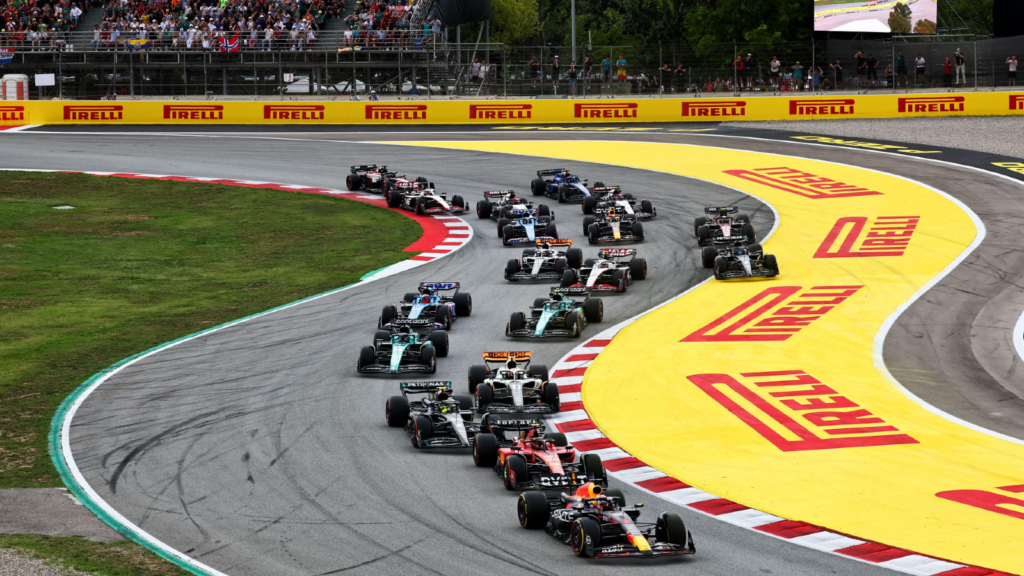The Spanish Grand Prix circuit (hosted at the Circuit de Barcelona-Catalunya) is one of the most diverse and technical circuits on the F1 calendar. Its range of low-speed corners, long sweeping turns, and long straights make it a true test of both machine and driver skill. Here’s an insider look at how an F1 driver navigates this iconic track.
Spanish Grand Prix Circuit – Track Overview
The Spanish Grand Prix, based in Montmeló just north of Barcelona, is a medium to high-speed track. It’s considered quite abrasive, meaning tire degradation can be substantial, especially during the warmer conditions.
The Track length is 4.655 km and in a normal F1 race 66 laps are covered. With six wins to his name at the circuit Michael Schumacher holds the record of the most wins.
Teams often have to carefully balance outright pace with tire conservation.
F1worldwide.com Recommends
- Austrian Grand Prix: The Ultimate Guide for F1 Fans
- The Austrian GP Circuit a Corner by Corner Breakdown
- British Grand Prix – Learn How to Drive on Silverstone
- Hungarian GP – Drive it and Understand the Sheer Skill Required
- Everything you need to know about Max Verstappen
- Yuki Tsunoda: The Japanese F1 Driver Making Waves
Spanish Grand Prix Circuit – Main Straight

The main straight of the Circuit de Barcelona-Catalunya allows drivers to push their cars to the limit. F1 cars can reach speeds of up to 330km/h (205mph) before the first turn.
The adrenaline rush here is palpable, with drivers experiencing upwards of 1.5G under acceleration.
Spanish Grand Prix Circuit – Turn 1 & 2 (Elf)

Entering the first turn, drivers brake hard, subjecting themselves to deceleration forces of around 4.5G. The entry speed into Turn 1 is around 100km/h (62mph), taken in third or fourth gear. The best driving line is wide on entry, cutting to the apex and then letting the car run out wide again to prepare for Turn 2. Turn 2 is a continuous part of the opening sequence and doesn’t require additional braking, taken smoothly with an exit speed of around 150km/h (93mph).
Spanish Grand Prix Circuit – Turn 3 (Renault)
One of the most iconic corners, Turn 3 is a long right-hander where cars maintain speeds of around 260km/h (162mph). The lateral G-forces here can reach up to 4G.
The best line is to stay tight to the apex, ensuring a smooth exit onto the next straight.
Spanish Grand Prix Circuit – Turn 4 (Repsol)
Drivers brake down to around 120km/h (75mph) for Turn 4. They experience approximately 3G during braking.
The corner is wide on entry, allowing different driving lines, but the general consensus is to stay close to the apex and accelerate hard out of the corner.
Spanish Grand Prix Circuit – Turns 5 through 9 (Seat, Würth and Campsa)

This section contains a mixture of medium and high-speed corners, challenging drivers’ reflexes and their car’s aerodynamic efficiency.
A good balance between downforce and drag is crucial here. G-forces, both lateral and longitudinal, oscillate between 2G to 4G depending on the specific corner and braking zone.
Spanish Grand Prix Circuit – Turn 10 (La Caixa)
This is a sharp left-hander. Drivers need to brake hard, reducing speeds to about 65km/h (40mph), experiencing around 3.5G during deceleration. The ideal line involves hugging the inside curb before letting the car run wide for the exit.
Spanish Grand Prix Circuit – Turns 11 through 15 (Banc de Sabadell, Europcar)
These are taken at varying speeds from 90km/h (56mph) to 200km/h (124mph), with a series of quick direction changes that test the agility of the car. G-forces here hover around 3G.
Spanish Grand Prix Circuit – Turn 16 (New Holland)
The final corner, drivers approach at around 220km/h (137mph) and exit at speeds close to 250km/h (155mph).
It’s crucial to get this corner right as it leads onto the main straight. Exiting well can mean the difference between defending a position or making an overtaking move into Turn 1.
Conclusion
The Circuit de Barcelona-Catalunya is not just a test of speed but of endurance, technique, and strategic understanding. The mix of corners and straights means drivers and teams must be on top of their game, balancing the need for speed with the preservation of tires.
As viewers, we’re treated to a display of sheer skill and prowess every time an F1 driver takes on this iconic circuit.

